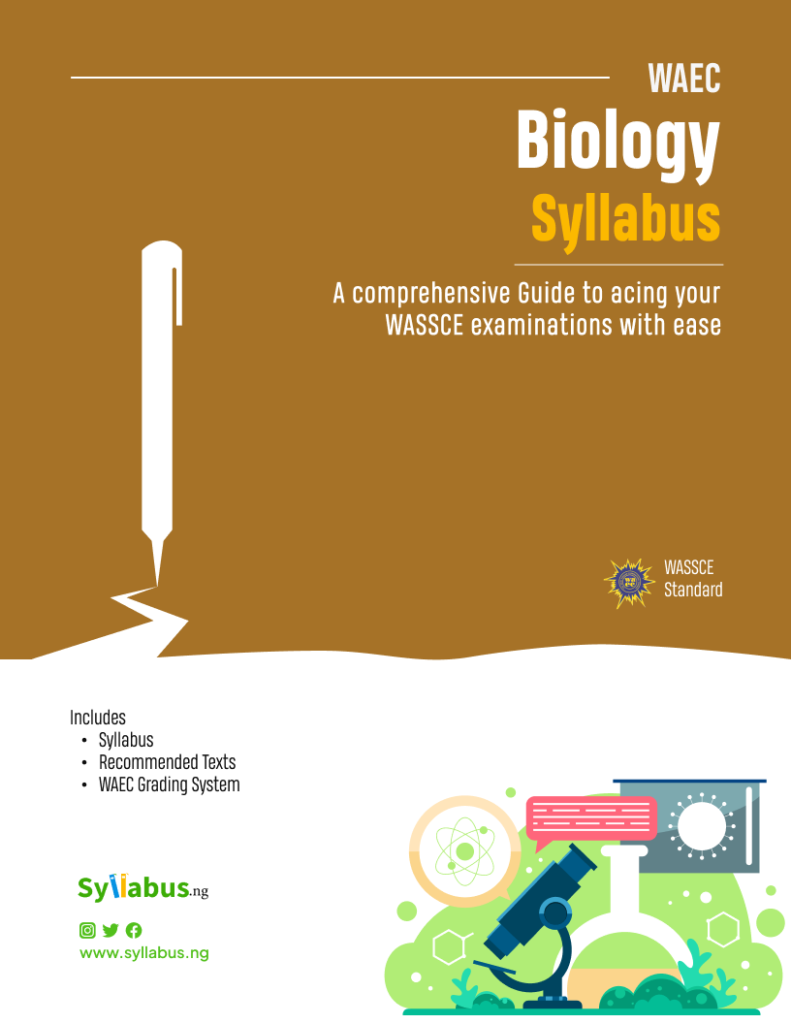Ace your WAEC Biology exam when you study with this approved WAEC syllabus. Stop studying without directions. Study smart!

Home » WAEC Syllabus » WAEC Biology Syllabus
This WAEC Biology syllabus is an excellent material for all who are preparing for the WAEC exam and will be writing Biology.
It states the key topics you should read for your exams as well as the main areas of focus that will be covered in the exam, like the basic concept of living, adaptation and evolution, animal supporting systems, and heredity.
Aside from a list of topics and their objectives, you also get a list of recommended textbooks and other resources that will help you prepare for your exam.
Download, study, and read this syllabus and when you are done, test just how prepared you are by solving past questions and see how prepared you are for your exams.
Good luck!
This examination syllabus is divided into three sections:
Section A is for all candidates
Section B is for candidates in Ghana only
Section C is for candidates in Nigeria, Sierra Leone, The Gambia, and Liberia.
There will also be three papers:Paper 1, Paper 2, and Paper 3
All papers must be taken. Papers 1 and 2 will be taken in one sitting.
Paper 1
It will consist of fifty multiple-choice objective questions drawn from Section A of the syllabus (the section of the syllabus that is common to all countries). It will carry 50 marks and last for 50 minutes.
Paper 2
Will consist of six essay questions drawn from the entire syllabus and will be divided into sections A, B, and C.
•Section A
It will consist of four questions drawn from Section A of the syllabus.
•Section B
It will be for candidates in Ghana only and will be drawn from Section B of the syllabus (i.e. the section of the syllabus peculiar to Ghana). It will consist of short-structured questions.
•Section C
It will be for Nigeria, Sierra Leone, The Gambia, and Liberia candidates. It will also consist of short-structured questions.
Candidates will be expected to answer two questions from Section A and all the short-structured questions from either Section B or Section C.
Section A’s questions will carry 20 marks, while the compulsory short-structured questions in Sections B and C will carry 30 marks. The total score will be 70 marks.
The paper shall take 1 hour and 40 minutes.
Paper 3
Will be a practical test (for school candidates) or a test of practical work (for private candidates) lasting 2 hours and consisting of sections A, B, and C.
•Section A
This will consist of two compulsory questions drawn from Section A of the syllabus, each carrying 25 marks.
•Section B
This will be for candidates in Ghana only. It will consist of one question from Section B of the syllabus and will carry 30 marks.
•Section C
This will be for Nigeria, Sierra Leone, The Gambia, and Liberia candidates.
It will consist of one question from Section C of the syllabus and will carry 30 marks.
Candidates will be expected to answer all the questions in Section A and one in either Section B or C.
The paper will carry a total score of 80 marks.

Excelling your WAEC Biology exam starts from knowing what’s expected of you.
Don’t be left behind. Download the Syllabus today.
| WAEC Biology SYLLABUS | ||
| SN | TOPICS | OBJECTIVES |
| PART A | ||
| 1 | CONCEPT OF LIVING | i. Living and non-living things ii. Classification of living things into Kingdoms: Monera, Protoctista (Protista), Fungi, Plantae, Animalia. iii. Differences between plants and animals |
| 2 | ORGANIZATION OF LIFE | i. Cell (single-celled organisms): Amoeba, Euglena, Paramecium ii. Tissue: Hydra iii. Organ (storage organ) bulb, rhizome and heart. iv. System/Organ System: In mammals, flowering plants – reproductive, excretory systems, etc. v. The complexity of organization in higher organisms: advantages and disadvantages. |
| 3 | FORMS IN WHICH LIVING CELLS EXIST. | i. Single and free-living: Amoeba, Paramecium, Euglena, and ii. Colony: Volvox iii. Filament: Spirogyra iv. Part of a living organism: Cheek cells, onion root tip cells and epidermis of fleshy leaves. |
| 4 | CELL | i. Cell structure and functions of cell components ii. Similarities and differences between plant and animal cells iii. The Cell and its environment: Physical and Biophysical processes; iv. Properties and functions of the living cell; |
| 5 | CELLULAR RESPIRATION | Definition and processes of: i. aerobic respiration ii. anaerobic respiration iii. energy release |
| 6 | EXCRETION | i. Excretion in single-celled aquatic organisms. Diffusion by body surface and by the contractile vacuole. ii. Waste products of metabolism |
| 7 | GROWTH | i. Basis of growth – cell division (mitosis), enlargement and differentiation. ii. Aspects of growth: Increase in dry weight, irreversible increase in size and length and increase in the number of cells iii. Regions of the fastest growth in plants iv. Influence of growth hormones and auxins v. Growth curvatures (Tropisms) vi. Development: Enlargement and differentiation vii. Movement a) Organelles for movement: cilia and flagella b) Cyclosis |
| 8 | REPRODUCTION | Types of reproduction. i. Asexual: fission, budding and vegetative propagation. ii. Sexual: Conjugation, formation of male and female gametes (gametogenesis), a fusion of gametes fertilization) |
| 9 | SKELETON AND SUPPORTING SYSTEMS IN ANIMALS | Biological significance. i. Skeletal materials, e.g. bone ii. Cartilage and chitin iii. Types of skeleton iv. The exoskeleton, endoskeleton and hydrostatic skeleton. v. Bones of the vertebral vi. Column, girdles and long bones of the appendicular skeleton. vii. Mechanism of support in animals. viii. Functions of the skeleton in animals: |
| 10 | DIFFERENT TYPES OF SUPPORTING TISSUES IN PLANTS | i. Main features of supporting tissues in plants ii. Functions of supporting tissues in plants: strength, rigidity (resistance against the forces of the wind and water), flexibility and resilience |
| 11 | TRANSPORT SYSTEM | i. Need for transport a) surface area/volume ratio b) substances have to move greater distances. ii. Transport in animals a) Structure of the heart, arteries, veins and capillaries. b) Composition and function of blood and lymph. c) Materials for transport: excretory products, gases, digested food, and other nutrients iii. Transport in plants a) Uptake and movement of water and mineral salts in plants. iv. Movement of water to the apex of trees and herbs |
| 12 | RESPIRATORY SYSTEM | i. Body surface: cutaneous, gills and lungs ii. Mechanisms of gaseous exchange in fish, toads, mammals and plants. |
| 13 | EXCRETORY SYSTEM | i. Excretory Systems and Mechanisms ii. Types of excretory systems: Kidney, stomata and lenticels iii. Characteristics of excretory organs in these systems should be studied. iv. Candidates should observe, draw and label the excretory organs of a small mammal (e.g. rat) v. Explanation of the concept of excretion in plants. Plant excretory products (water, carbon dioxide, oxygen, alkaloids, tannins, gums, resins and acids) should be mentioned. |
| 14 | REGULATION OF INTERNAL ENVIRONMENT (HOMEOSTASIS) | i. Kidney: Structure and functions ii. Liver iii. Functions of the liver iv. The skin: Structure and function |
| 15 | HORMONAL COORDINATION | i. Animal hormones: Site of secretion, functions and effects of over and under-secretion ii. Plant hormones |
| 16 | NERVOUS COORDINATION | i. The central nervous system a) Components of the central nervous system b) Parts of the brain and their functions; cerebrum, cerebellum, medulla oblongata, hypothalamus and their functions c) Structure and function of the Spinal Cord. ii. Peripheral Nervous System. a) Somatic Nervous System b) Autonomic nervous system c) Structure and functions of the neurone d) Classification of neurones iii. Types of nervous actions a) The reflex arc b) Reflex and voluntary actions c) Differences between reflex and voluntary actions. d) Conditioned reflex and its role in the behaviour |
| 17 | SENSE ORGANS | i. Structure and function of the a) Eye b) Ear |
| 18 | THE REPRODUCTIVE SYSTEM OF MAMMALS | i. The reproductive system of mammals ii. Metamorphosis in insects, life histories of butterfly and cockroach iii. Comparison of reproduction in fish, amphibians, reptiles, birds and mammal iv. Reproduction in flowering plants v. Pollination in Plants vi. Process of development of zygote in flowering plants vii. Dispersal of fruits and seeds: Agents of dispersal |
| 19 | PLANT AND ANIMAL NUTRITION | 1. Plant Nutrition i. Photosynthesis: Process of photosynthesis and its chemical equation Light and dark reactions Materials and conditions necessary for photosynthesis Evidence of photosynthesis ii. Mineral requirement of plants Mineral nutrition: Macro and micro-nutrients Soil and atmosphere as sources of mineral elements 2. Animal Nutrition i. Food substances; classes and sources ii. A balanced diet and its importance iii. Digestive enzymes: Classes, characteristics and functions iv. Modes of Nutrition a) Autotrophic: Photosynthesis, b) Heterotrophic: holozoic, parasitic, symbiotic and saprophytic v. Alimentary System: Alimentary tract of different animals vi. Dental Formula vii. Feeding in protozoa and mammals |
| 20 | BASIC ECOLOGICAL CONCEPTS | i. Ecosystem: Components of the ecosystem and sizes ii. Ecological factors: Ecological factors in aquatic and terrestrial ecosystems iii. Simple Measurement of Ecological Factors. iv. Food webs and trophic levels v. Energy flow vi. Decomposition in nature vii. Ecological Management: viii. Pollution of the atmosphere ix. Water and Soil Pollution x. Ecology of population xi. Factors that affect the population size: natality, mortality, emigration, immigration, food shortage, predation, competition and diseases. xii. Preservation and storage of foods xiii. The life of selected insects; xiv. Microorganisms: Man and health |
| 21 | CONSERVATION OF NATURAL RESOURCES | i. Resources to be conserved: soil, water, wildlife, forest and minerals. ii. Ways of ensuring conservation |
1. Ndu, F.O. C. Ndu, Abun A. and Aina J.O. (2001) Senior Secondary School Biology: Books 1 -3, Lagos: Longman.
2. Odunfa, S.A. (2001) Essential of Biology, Ibadan: Heinemann.
3. Ogunniyi M.B. Adebisi A.A. and Okojie J.A. (2000) Biology for Senior Secondary Schools: Books 1 – 3, Macmillan.
4. Ramalingam, S.T. (2005) Modern Biology, SS Science Series. New Edition, AFP
5. Stan. (2004) Biology for Senior Secondary Schools. Revised Edition, Ibadan: Heinemann
6. Stone R.H. and Cozens, A.B.C. (1982) Biology for West African Schools. Longman
7. Usua, E.J. (1997) Handbook of practical Biology 2nd Edition, University Press, Limited
Some of the topics are Cells, The Skeleton and supporting systems in animals, Sense organs, plant and animal nutrition, etc. A full list of the topics and their objectives are in the syllabus outlined above.
Paper 1 will consist of 50 objective questions and Paper 2 will have roughly 6 questions and you have to answer 4.
Yes, there is also a practical section which is paper 3. It will not be taken on the same day as papers 1 and 2 but it is made compulsory.
Paper 1 and 2 which will be taken together will last for roughly 2 hrs 30 minutes while paper 3 will last for 2 hours.
To create a good study schedule, I would advise you to draw up a reading timetable for all the subjects you will be taking in the WAEC exams. With this, you know the subjects you are to read for the day and the number of hours for each.
Practice, practice, practice. Study the syllabus, recommended textbooks, notes, and past questions together. You can also ask your teacher or tutor questions on topics you don’t understand.
All recommended texts are outlined in the article above. You should also add your past questions booklet to it.

Excelling your WAEC Biology exam starts from knowing what’s expected of you.
Don’t be left behind. Download the Syllabus today.